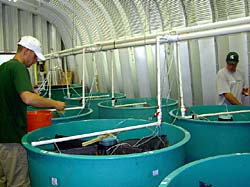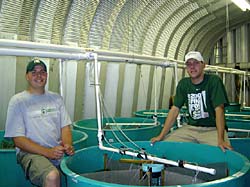2005 Lake Sturgeon Research
2005 Annual Research Review
By Jamie Crossman and Patrick Forsythe, Graduate Students, Michigan State UniversityWe had an exceptional year in terms of what we accomplished towards reaching our research objectives. We obtained much new and needed information on various aspects of the lake sturgeon's biology and reproductive ecology.

We were very successful in capturing a large proportion of the adult spawning in each of the four runs that we observed.
A total of 154 lake sturgeon were captured and tagged, 46 females and 108 males. To date we have tagged a total of 423 unique individuals (257 males, 166 females) during the past 5 years.
Eggs were collected from 14 females resulting in 27 different families reared at our stream side hatchery at the mouth of the Upper Black River. To give the fish themselves some credit, they were very successful in reproducing, given the large number of larval fish that we captured drifting downstream over a month of sampling (7,434). We were also able to determine that a dramatic loss of eggs occurs over time. This loss is most likely attributed to both instream characteristics and the eggs high vulnerability to fungal infection soon after fertilization.
Our stream side hatchery ran smoothly throughout the summer and fortunately we did not run into any problems. This success was responsible for stocking a large number of fish back (~8,000) into the Upper Black River on two separate occasions and the entire Cheboygan watershed, i.e. Burt (~350) and Mullett Lake (~350). We learned that fish reared at our hatchery on the Upper Black were captured at a much higher rate than those reared at a hatchery downstate. We are in the process of designing experiments to identify why this process might occur. These experiments combined with the knowledge we gained about rearing lake sturgeon will facilitate the development of recovery plans, management strategies, and the long term conservation of this species.

We are currently holding a number of fish that will be receiving acoustic transmitters in early December. This includes both fish that were hatched at the Black Lake hatchery in natal water and those reared in traditional hatchery conditions. These 40 fish (currently ~12 inches total length) will be released into Black Lake and will allow us to assess the differences in movements between each of the two rearing locations. We will be manually tracking throughout the winter months.
In closing we would like to once again thank all the help we have received this past year. Sturgeon for Tomorrow, the MiDNR, and local residents made for a productive and fantastic year.
See you on the lake.
- Home Page
- Black Lake
Sturgeon Shivaree - Black Lake Watershed
- Black Lake Sturgeon Management Plan
- Committees
- Contact Us
- Directors
- Events
- Habitat Conservation
- Membership
- Newsletters
- Our History
- Photo Gallery
- Research
- Resources
- Resources for Educators
- SFT Scholarships
- Spearing Guidelines
- State Regulations
- Sturgeon Guarding
- Sturgeon Hatchery
- Sturgeon in the Classroom

